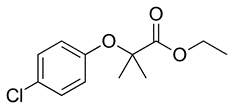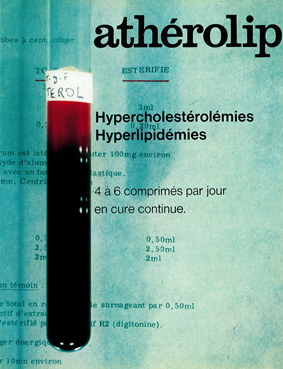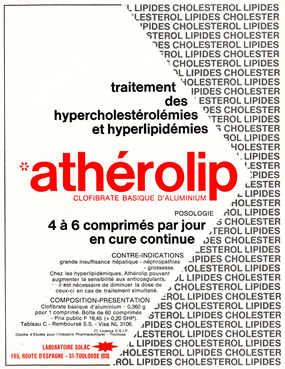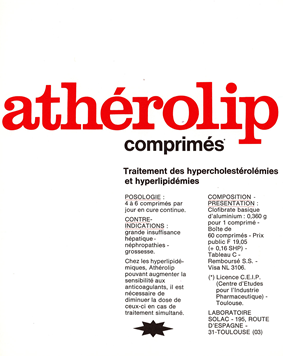Clofibrate, the active principle of the drug Athérolip, has been used for more than 60 years for the treatment of hyperlipidemia in patients with high cholesterol and triaglyceride levels in the blood. It was the only lipid-lowering drug available in the early 1960s, then extensively used in the 1970s worldwide, until 2002 when the drug was withdrawn from the US market because of its adverse effects (gastrointestinal and musculoskeletal) and lack of long-term effect in reducing cardiovascular mortality.
Clofibrate facilitates the conversion of very-low-density lipoprotein (VLDL) to low-density lipoprotein (LDL), thereby inhibiting cholesterol production, and increasing fecal excretion of neutral sterols. A the molecular level, clofibrate is considered as an activator (agonist) of hepatic peroxisome proliferator-activated receptor alpha (PPARα), a transcription factor largely implicated in hypertriglyceridemia and dyslipidemia. PPARα regulates gene transcription of enzymes involved in lipid synthesis and secretion. Notably, PPARα plays an important role in mediating diabetic cardiomyopathy. PPARα activation with clofibrate exerts antioxidant, pro-vasodilator and anti-fibrotic effects, which can be useful to improve cardiac condition posterior to ischemia. Different fibrates, such as fenofibrate, bezafibrate and clofibrate have been extensively used, but there are now alternative options (statins) to treat hyperlipidemia. Nevertheless, fenofibrate remains in wide scale use today.

The use of fibrates leads to the release of clofibric acid which is a typical and widespread micropollutant in municipal wastewater. This xenobiotic compound is highly persistent in the aquatic environment and passes unchanged or poorly transformed in wastewater treatment plants. Technologies have been developed to eliminate this ubiquitous pollutant from wastewater





